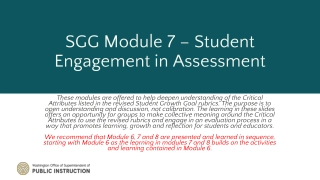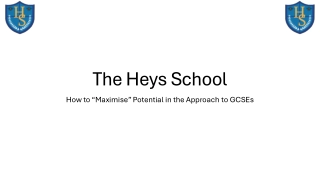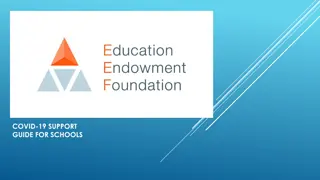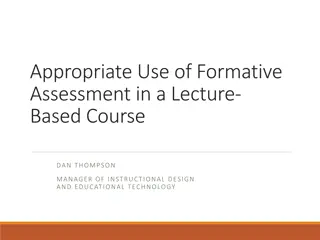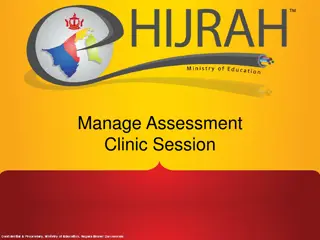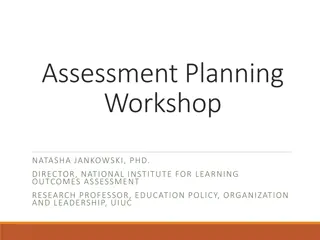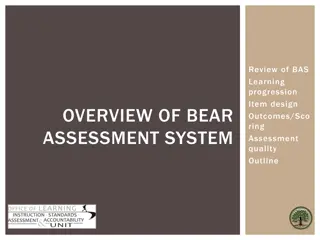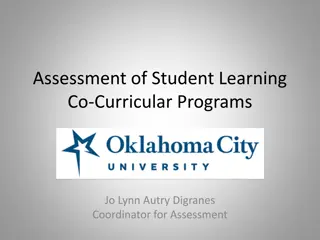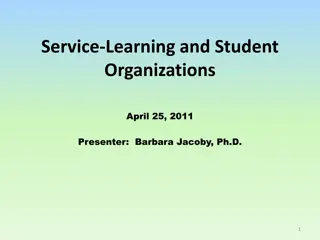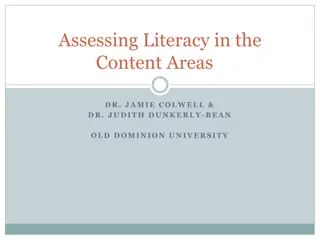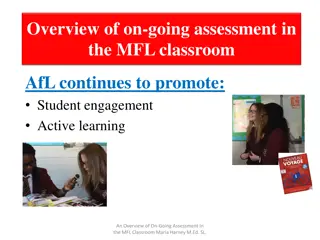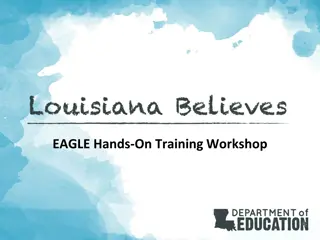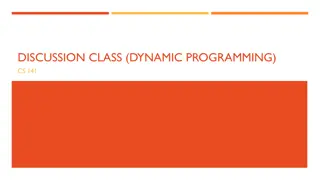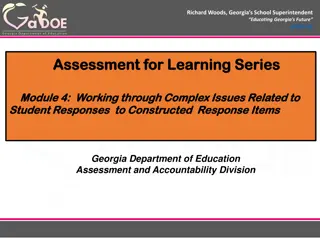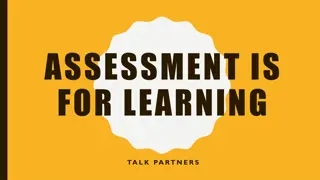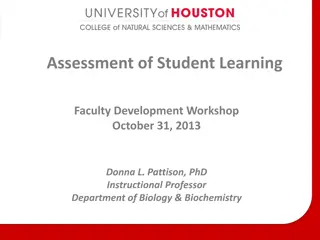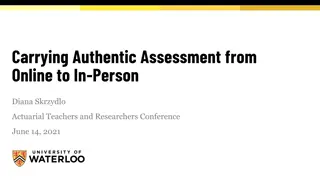Maximizing Student Learning Through Effective Assessment Strategies
Explore the importance of assessment for learning, learning intentions, and success criteria in educational settings. Discover how to create and implement effective learning intentions, success criteria, formative assessment, and feedback practices to drive student progress and achievement. Dive into the significance of asking effective questions, sharing learning goals, self and peer assessment, and providing constructive feedback. Enhance your understanding of crafting context-free learning intentions and optimizing English learning intentions for student success.
Download Presentation

Please find below an Image/Link to download the presentation.
The content on the website is provided AS IS for your information and personal use only. It may not be sold, licensed, or shared on other websites without obtaining consent from the author. Download presentation by click this link. If you encounter any issues during the download, it is possible that the publisher has removed the file from their server.
E N D
Presentation Transcript
ASSESSMENT IS FOR LEARNING LEARNING INTENTIONS AND SUCCESS CRITERIA
Effective questio- ning Sharing learning goals Self and peer assessment Formative Assessment Underpinned by a belief that all learners can make progress; that achievement comes from effort not just ability. Effective feedback
Effective questio- ning Sharing learning goals Self and peer assessment Formative Assessment Effective feedback
LEARNING INTENTIONS We will understand what makes a good Learning Intention We will know how to create effective Success Criteria We will be able to use Learning Intentions and Success Criteria confidently in our own classes
Learning Intentions describe what learners should know, understand or be able to do by the end of the lesson or a series of lessons.
THINK PAIR Come up with a Learning Intention for a lesson you taught today.
THINK PAIR SHARE Explain what makes a good Learning Intention. How do you share them? When do you mention them? What are you using them for? How should they be worded?
WHAT MAKES A GOOD LEARNING INTENTION? Be presented at or near the start of a lesson and be referred to throughout. Be visible throughout the lesson (for both pupils and teachers to refer to). Be based on the Experiences & Outcomes at BGE. Be context-free so pupils realise there are many reasons for learning the concept. Focus on what learners will learn, not what learners will do. Be written in language that learners will understand. Use words that centre on learning and skills, like: We are learning to We will be able to We will know
CONTEXT-FREE LEARNING INTENTIONS We will understand what makes a good English Learning Intention.
CONTEXT-FREE LEARNING INTENTIONS We will understand what makes a good English Learning Intention.
CONTEXT-FREE LEARNING INTENTIONS We will understand how the writer develops Katniss character. We will be able to conduct a safe experiment using light bulbs. We will know how to create a bar graph to show people s lunch habits.
CONTEXT-FREE LEARNING INTENTIONS We will understand how writers develop character. (context: Katniss in The Hunger Games ) We will be able to conduct a safe experiment. (context: light bulbs) We will know how to create a bar graph to present data. (context: vote about lunch habits)
LEARNING BASED LANGUAGE It may help to use one of the following phrases to base your Learning Intentions around: To know if the learning centres around the pupils knowledge about a particular topic, or their knowledge of how to do something, or knowledge of why something happens; for example: We will know how to construct a pie chart. I will know what characterisation means.
To be able to if the learning is skills based; for example; We will be able to write persuasively. I will be able to take part in an effective group discussion.
To understand if the learning builds on the pupils knowledge and requires them to analyse or interpret something; for example: We will understand the effects of diet on health. I will understand the importance of using full stops.
IMPROVED LEARNING INTENTIONS Unclear LI To present an argument for and against euthanasia Improved LI To be able to present a reasoned argument including for and against positions Improvement Using learning based language ( to be able to ); context ( euthanasia ) free To know what the local minister does We will write a letter of complaint to the council about the lack of bins in the park To know the duties of a religious leader We are learning to use the correct features of a formal letter Removing context ( the local minister ) Focussing on knowledge ( We are learning to use ) rather than product; based on a genre of writing outlined by E&Os ( formal letter ); and context free
TASK In a pair or a trio, read the Learning Intentions on the next slide and traffic light them based on how effective they seem to you. For any you think are amber or red, discuss how they could be improved.
1. 2. 3. 4. 5. 6. 7. 8. I will be able to produce and analyse a questionnaire about movie-going habits. We will understand the effect of certain suffixes. We are setting personal goals. We will know ways that floods in Bangladesh could be controlled. I will write a complete story. We are doing negative numbers. I will understand the effect of exercise on the heart (long term learning intention). I will be able to plan and conduct a fair test (short term learning intention). We are learning to describe the differences between plant and animal cells.
1. I will be able to produce and analyse a questionnaire about movie-going habits. I will be able to construct and analyse data We will understand the effect of certain suffixes. We are setting personal goals. We will be able to set personal goals. We will know ways that floods in Bangladesh could be controlled. I will write a complete story. I will be able to write creatively. We are doing negative numbers. We will be able to subtract negative numbers. I will understand the effect of exercise on the heart (long term learning intention) I will be able to plan and conduct a fair test (short term learning intention) 8. We are learning to describe the differences between plant and animal cells. 2. 3. 4. 5. 6. 7.
Look at your own Learning Intention from the start Does it fulfil our criteria? If not, rewrite it so that does. You may need to: Remove context Focus the language on learning ( We will be able to , I will know , I will understand ) Focus on what the pupil will learn rather than do
T-P-S As well as outlining what learning will take place in a particular lesson, are there any other effective uses of Learning Intentions?
As a Prior Knowledge/Planning tool As a Plenary tool Part of wall displays to reinforce and remind later Long and short term Learning Intentions As a starter discussion task
LEARNING INTENTIONS We will understand what makes a good Learning Intention We will know how to create effective Success Criteria We will be able to use Learning Intentions and Success Criteria confidently in our own classes
SUCCESS CRITERIA Success Criteria are the measures used to determine whether and how well a learner has met the Learning Intention. The pupils learning should be assessed against the Success Criteria. One Learning Intention = At least one Success Criteria
EFFECTIVE SUCCESS EFFECTIVE SUCCESS CRITERIA CRITERIA Are linked to the learning intention Are co-created with pupils Are written in language that learners understand Provide a scaffold and focus for learners while engaged in the activity. Are used as the basis for teacher feedback, peer feedback and self-assessment. Are limited in number so learners are not overwhelmed by the scope of the task Focus on the learning and not on aspects of behaviour (eg paying attention, contributing, meeting deadlines etc.)
PRODUCT VS PROCESS The most effective Success Criteria will give pupils a guide to the correct process they need to go through to achieve the Learning Intention, rather than just telling them the product they will finish with.
TYPES OF SUCCESS CRITERIA PRODUCT PROCESS What pupils will be able to do or have by the end of the lesson(s) What key steps pupils need to take in order to fulfil the Learning Intention
TYPES OF SUCCESS CRITERIA Learning Intention: We will be able to change a tyre. PRODUCT What pupils will be able to do or have by the end of the lesson(s); for example: You will have a tyre which is full of air and safe to drive on PROCESS What key steps pupils need to take in order to fulfil the Learning Intention; for example; Remember to: Find a safe location to stop. Turn on your hazard lights. Apply the hand brake. Remove the hubcap or wheel cover. Loosen the lug nuts.
TYPES OF SUCCESS CRITERIA Learning Intention: We will be able to write persuasively. PRODUCT PROCESS What key steps pupils need to take in order to fulfil the Learning Intention; for example: What pupils will be able to do or have by the end of the lesson(s); for example: You will have written a persuasive essay. Things to remember: Use an engaging opening (for example, a shocking statistic, a question, an anecdote) Include persuasive writing techniques throughout (CARPETS) Include and explain evidence Use an effective conclusion (for example, a challenge to the reader, a reference to the introduction, a positive tone)
TYPES OF SUCCESS CRITERIA Learning Intention: We will understand how to calculate the area of a triangle. PROCESS PRODUCT What pupils will be able to do or have by the end of the lesson(s); for example: You will know how to use the correct formula when calculating the area of a triangle. What key steps pupils need to take in order to fulfil the Learning Intention; for example: Remember to: Identify and measure the base and height Multiply the base by the height and divide by 2 Record in appropriate units
EFFECTIVE SUCCESS EFFECTIVE SUCCESS CRITERIA CRITERIA However, they don t guarantee quality teaching, exemplification, feedback and practice do this. It is important to: Encourage pupils to listen to other students responses Show pupils exemplar work which does not meet the assessment criteria in order to think about next steps for improvement Show pupils high quality exemplar work and highlight how it meets the assessment criteria
TASK Look at the Success Criteria on the following slides and traffic light them, based on the criteria discussed.
LI = I will be able to write a report. SC = Remember to: Include headings. Include appropriate pictures / diagrams / tables. Use a formal tone throughout. Avoid opinions or emotive language. Include a conclusion.
Not too many All helpful and connected to report Compulsory steps LI = I will be able to write a report. SC = Remember to: Include headings. Include appropriate pictures / diagrams / tables. Use a formal tone throughout. Avoid opinions or emotive language. Include a conclusion.
LI = We will understand advantages and disadvantages of different types of government. SC = You should make: A list of advantages of democracy. A list of disadvantages of dictatorship. A list of disadvantages of communism.
LI = We will understand advantages and disadvantages of different types of government. SC = You should make: A list of advantages of democracy. A list of disadvantages of dictatorship. A list of disadvantages of communism. Product based Very prescriptive Pupil language
LI = The learner will be able to link understanding of numbers in other areas. SC: The learner can: use addition and subtraction in real life contexts (e.g. to measure and use money).
LI = The learner will be able to link understanding of numbers in other areas. SC: The learner can: use addition and subtraction in real life contexts (e.g. to measure and use money). No helpful steps Not pupil friendly
LI = To be able to analyse imagery. SC= Method: Identify an example of imagery from the text. Work out what is being compared to what. You must: work out what these things have in common. You should: explain what this helps you understand about the original subject. You could: explain why the description is more effective with imagery
Pupil friendly Helpful steps to complete process Differentiated LI = To be able to analyse imagery. SC= Method: Identify an example of imagery from the text. Work out what is being compared to what. You must: work out what these things have in common. You should: explain what this helps you understand about the original subject. You could: explain why the description is more effective with imagery
TASK In a pair or a trio, using one of your own Learning Intentions from earlier (or one from below if you d rather), come up with a rough set of process Success Criteria which would help pupils to achieve it We will be able to write persuasively. We will know ways of controlling drought. We will be able to multiply fractions. I understand how to take part in an effective group discussion. I understand how to stay safe online. (Context: creating an Internet Safety Leaflet)
GENERATING SUCCESS CRITERIA Recommended that this is done with pupils, in their language What strategies could we use to help pupils do this?
GENERATING SUCCESS CRITERIA Look at the Learning Intention and discuss how we will know we have achieved it (as we did at the start) Look at an exemplar of work first (like a piece of writing; a solution to a question; a video of someone doing the high jump) and discuss its strengths (or weaknesses) these then form the Success Criteria; alternatively, you could give two pieces of work, of different quality and use these to generate a list of what makes one of them better. Do the task yourself (either correctly or incorrectly) and have pupils note what you are doing as you do it.
GENERATING SUCCESS CRITERIA Give possible answers to a question, then get pupils to pick which are right and wrong, and discuss why this is. Let pupils attempt the activity first, and then get them to explain their step by step process. If you end up with an extremely long list of criteria, discuss with pupils which are the most important; some Success Criteria can be like a pick and mix menu not every single one needs to be used
T-P-S How can we make effective use of Success Criteria during lessons?
EFFECTIVE WAYS OF USING SUCCESS CRITERIA After a five minute warning, stop the class, draw attention to one criteria, and have pupils check own or peer s work for this criteria To differentiate, everyone has same criteria but some are identified (by teacher or class) as vital; everyone focuses on these ones, while more able or adventurous pupils focus on them all pupils can take ownership of this and decide themselves Before end of work (ie half way through, not immediately before handing in), have pupils traffic light Success Criteria; this gives teacher a chance to refocus certain learners on certain criteria
EFFECTIVE WAYS OF USING SUCCESS CRITERIA Have pupils assess their own or a peer s work against the criteria before they submit piece; if the Success Criteria is a set list of required ingredients, this gives pupils a chance to spot anything they have missed For commonly occurring tasks, Success Criteria could be constantly stuck on the wall Base feedback on criteria and give specific instructions on how work can be improved Return to at the end and amend did anything end up not being important? Did something occur that was crucial during the process?
LEARNING INTENTIONS We will understand what makes a good Learning Intention We will know how to create effective Success Criteria We will be able to use Learning Intentions and Success Criteria confidently in our own classes
GOING FORWARD Pair up with another teacher from your school and share these key messages on Learning Intentions and Success Criteria During the next week, aim to make use of one of these strategies, whether it is: Using visible Learning Intentions and referring to them throughout lesson Using long term and short term Learning Intentions Sharing Learning Intentions in advance to gauge prior knowledge Creating Success Criteria with your class One of the self / peer assessment methods based on Success Criteria Once you have practised your new strategy, arrange for your partner to observe part of a lesson when you make use of it


